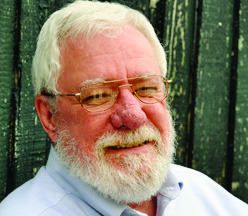Bradshaw
George Lewis Moscovis was known to his fellow World War II airmen as a hard-working, clean-living, God-fearing man who carried a Bible on every combat mission. He was not prone to salty language, but I wouldn’t blame him if he had been tempted to use one or two off-color words on August 20, 1944, a really, really bad day. He had just been forced to jump from a burning B26 bomber and realized that his parachute was not going to open.
The young man from Opelousas was on his 29th combat mission as a gunner on the B26 Marauder nicknamed “Flossie’s Fury” when it was shot down. The headline from a story written in March 1945 tells what happened next: “They Found His Body and Believed Him Dead, Prepared Him for Burial, But He Opened His Eyes and Smiled.”
That was a happy ending but was far from the way things were planned. Sunday, August 20, was the anniversary of his squadron’s formation. A party was planned when the bombers returned that evening. But before they could enjoy the good food and beer, George and the rest of Flossie’s crew had work to do, bombing big German guns guarding the harbor at Toulon, on the south coast of France. Flossie’s bombs destroyed several guns but not the one that sent shells crashing into the left side and right wing of the plane.

Bradshaw
George and fellow gunner Bob McClusky, stunned and hurt, immediately realized that the plane was doomed. “I started crawling back toward the tail to the waist window, when I saw McCluskey pinned under a bunch of flak suits,” George later told military historian Charles O’Mahoney. “They were really heavy because of the G-forces, but I dragged the suits off him and got him to the waist window. There was no gun mounted in the left window, and I helped him go out, head first. We were low by then, and I knew I had to get out. I squeezed out the waist window, and that’s the last thing I remember.”
A photo taken from another airplane shows the plane’s right engine falling away and flames billowing from the wing. Flossie’s Fury crashed and exploded seconds after the picture was taken, and just seconds after George had jumped from it.
George passed out during his 1,200-foot free fall and he had no idea how he survived. The supposition is that tree branches broke his fall and saved his life. He was in a deep coma when German troops found what they believed was his lifeless body, looted it of everything valuable, and ordered some French civilians to get rid of the remains.
The civilians, also believing he was dead, took George to a small shed and laid him on a table while they made a crude casket out of ammunition boxes. George did not stir until, just as they began to ease the body from the table into the coffin, he blinked his eyes and smiled at what he described as “beautiful women” who surrounded him. The startled women were members of the French Underground who’d risked their lives to give him a decent burial.
“They started to kiss me,” George recalled during the 1945 interview from his Florida hospital bed. “They all began to cry. Then darned if I didn’t start to cry, too.”
Germans still occupied Toulon, and men and women of the French resistance risked their lives for several days to hide George and get him medical help. “About four days later, these free French had got me to a hospital, and they said they had a surprise for me,” he recalled. “Into my room walked Bob Mc-Cluskey. I couldn’t believe it and neither could he. We both cried like babies; each of us had thought the other was dead.” McClusky was the only other survivor of the crash. Six airmen died.
After the war, George returned to Opelousas, married Lottie Kessinger, and worked for the next 20 years as a machinist and foreman for Standard Fittings. After retiring from Standard, he worked for another 20 years as a St. Landry Parish school bus driver.
George Moscovis died peacefully at his home in Opelousas on August 26, 2006, at the age of 82. He was eulogized as a good, upstanding man and a war hero.
That recognition involved much more than surviving a crash. He was the recipient of the Distinguished Flying Cross, the Air Medal with seven Oak Leaf Clusters, the Purple Heart, and the French Croix de Guerre, that country’s equivalent of our Medal of Honor. The Distinguished Flying Cross and the Air Medal are given for acts of heroism. Seven oak leaf clusters meant he earned the Air Medal eight times.
You can contact Jim Bradshaw at [email protected] or P.O. Box 1121, Washington LA 70589.

